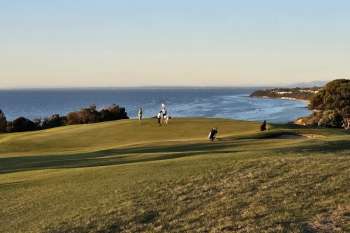A Glossary of Golf Course Architecture
Rereading an old master plan prepared by a signature designer, I was struck by the constant use of popular architectural phrases like ‘challenging hole’ and ‘strategic bunkering’. One sentence suggested that on a particular hole the ideal line for better golfers was ‘between strategically placed bunkers set into mounding right and left of the fairway’. The accompanying diagram showed an almost anorexic fairway, with bunkers tight on both sides.
Were these really strategically positioned bunkers, or is this another school of design altogether? It’s the sort of question engaged golfers should ask of their committee or appointed design consultants, whenever changes are proposed to their golf course. The more the members know about design the more likely they are to embrace sensible change or, equally, to reject inappropriate redevelopment.
To aid in the understanding of the business of golf design, we’ve compiled this brief dictionary of common architectural idioms. We’ve left out words like Redan, Dell, Alps and Biarritz, which refer to features found on the classic old links and copied many times since, for more basic terms that describe styles of design and elements found on the finished golf course. Hopefully by increasing your understanding of popular design words and phrases, your enjoyment for the game and the courses it’s played on will also increase.
TYPES OF COURSES
Links – Golf as it was originally played, by the sea and across rolling sand dunes. Fescue playing surfaces, variable winds and attractive seaside vegetation are essential for authenticity.
Parkland – Refers to inland golf courses with plenty of trees.
Stadium Course – Custom built to host tournaments, Stadium courses tend to be very long and dramatic, with abundant water hazards and peripheral mounding for spectator viewing.
Sandbelt – Refers to both an enlarged sandy tract of land in southeast Melbourne as well as the elite golf courses of that region, and the style of architecture collectively on display.
Heathland – Similar to the Melbourne Sandbelt, the Heathland refers to a region outside London city blessed with distinct natural vegetation (including heather) and a host of exceptional old golf courses.
DESIGN STYLES & PHILOSOPHY
Minimalism – The philosophy of least disturbance, minimalist designers believe the best golf holes/courses are created by retaining as much of the natural terrain and natural shape as possible.
Naturalism – All golf courses are man-made in some part, and the Naturalistic movement revolves around the idea that manufactured areas should appear as natural as possible.
Strategic – Even designers with a penal or prescriptive bent, are prone to describing their philosophy as being strategic, such is the overwhelming evidence that strategic golf makes the most sense. Strategic design is all about choices, and giving golfers the option of taking a risk in order to reduce the difficulty of a subsequent shot. Width is an essential ingredient of strategic golf, along with cleverly positioned hazards that tempt and test golfers across the ability spectrum.
Penal – Penal design differs from strategic design by forcing golfers to take risks and then punishing mistakes more than rewarding successful gambles. Penal courses are the most mundane, reducing the need for cerebral thought by instead prescribing how each hole must be played. Think water carry par threes, and narrow par fours and fives through trees, bunkers or thick rough. Little thought is needed; you simply step forward and hit the shots prescribed through design.
Heroic – Straddling the line between strategic and penal design, heroic holes are those that allow the golfer to take large risks in order to set up birdie opportunities. This often involves the carry of a hazard from the tee on a par four or five. Whereas a misplaced drive on a strategic hole might leave you with a poor approach angle, on an heroic hole it might leave you without a golf ball.
GREEN TERMS
Green Site – The actual location of a proposed or constructed green complex.
Green Complex – A term that describes not only the green itself, but the hazards (bunkers) and collection/chipping areas that immediately surround it.
Green (putting) Contours – The physical shape of the ground itself, and how the slopes within the green affect putting and approach play.
False Front – A false front usually refers to an elevated front section of green that is designed to reject weak shots and either stop them moving forward or send them back toward the approaching golfer. Generally there is a ridge or other landform that must be carried in order to reach the main section of green where the pins are located.
Pin Positions – Areas of green that are sufficiently level, and distant from green edges, to enable course staff to place cups and flags.
Buried Elephant – A popular method of describing a pronounced mound or hump on a golf course, usually through a putting green. Suggests the green was shaped by simply burying an elephant with turf.
Push-up Green – A green that is raised above its immediate surrounds, either naturally or through construction by pushing earth to create an artificial green plateau.
Double Green – Where two holes shared a common putting surface, the area is referred to as a Double Green. The Old Course at St Andrews has 7 (in other words servicing 14 holes).
BUNKER TERMS
Bunker Complex – A group or cluster of bunkers that work together to defend or define a particular section of the golf hole.
Revetted Bunker – Popular on the old links in Great Britain and Ireland, revetted bunkers are sod-faced bunkers that are built by stacking layers of turf on top of each other. Although more costly to maintain, revetting gives bunkers a fearsome appearance and can stabilise them from erosion on windy sites. NSW Golf Club in Sydney is one of the few in Australia with revetted bunkers.
Pot Bunker – Small and usually round, pot bunkers are common across the British links and often very deep and built with revetted faces.
COURSE FEATURES
Hazard – Generally refers to obstacles used in design to impede play and challenge the strategy of the golfer. Most common forms include bunkers, lakes, ponds and rivers but can also refer to vegetation and large landforms.
Forced Carry – A hole or fairway where the golfer has no option but to hit across a hazard.
Bailout Area – Usually set to the safer side of a green, the bailout area gives less aggressive or timid golfers the option of hitting safely away from a dangerous hazard. Often the recovery from this side of the green is more difficult than it appears.
Split Fairway – A landing area that is divided by hazards or natural features, and usually arranged so that one route is more dangerous than the other.
Turning Point – The point at which dogleg holes or bending fairways turn.
Centerline – A direct route from the middle of the tee box through the middle of the fairway and onto the middle of the green. Centreline’s and turn points are used to calculate the length of a hole.
GENERAL TERMS
Risk/Reward – A term used to describe a design strategy that allows the golfer to take a calculated risk on one shot in order to set up an easier/shorter subsequent shot.
Ground Game – Courses and holes that are designed to encourage golfers to bounce balls into target areas are said to encourage or promote the ‘ground game’. In simple terms it means that getting from Point A (ie fairway) to Point B (ie green) is best achieved via Point C (ie bouncy ground short of green).
Aerial Game – Courses and holes that are designed with hazards in front of targets are said to promote the aerial game, at the expense of the more traditional ground game. Hitting approach shots over bunkers into soft greens is easier for accomplished players, who tend to be better at controlling distances and striking shots consistently.
Target Golf – Golf that is played mostly through the air toward a soft, receptive target. See above, typically much easier for accomplished players.
Routing – The most important element of any golf course, the routing refers to the actual layout of the golf holes across the property.
Transition – How a golf course flows through the natural terrain and from green to tee, tee to fairway and hole to hole.
Playability – The ease with which a golf course tests and entertains a wide range of golfing abilities. Designing a hard course is simple. Designing one that strong, weak, professional and poor golfers alike can enjoy is a real challenge.
Golden Age – Depending on where you live or how you measure these sorts of things, the Golden Age of Golf Course Design refers to a period between the start of the 20th century and the Great Depression, when many of the world’s elite courses were created. In Australia the Golden Age generally invokes memories of the 1920s and early 30s, when the courses of Dr Alister MacKenzie and the men he mentored were finished.
Cookie-Cutter – An unflattering term used to describe a designer or design style that is repetitive and predictable.
Signature Design – The practice of celebrity professional golfers getting into the course design business, usually by hiring draftsmen, landscape architects or turf professionals to carry out design work in their name. Large signature companies are the most prolific in golf, and popular with clients for whom marketing a famous designer is more important than marketing a quality golf course.
Darius Oliver, Architecture Editor Australian Golf Digest Magazine
Back to NewsMore News
Report reveals golf's $3.3 billion contribution to Australia
AGIC report reveals total annual benefits to the Australian community, economy and environment from golf.
Cape Wickham Links – The Inside Design Story
Co-designer Darius Oliver reveals the truth behind the design of Australia’s premier modern golf course
Min Woo Lee signs up for Aussie PGA title defence
Reigning champion locks in the defence of his title at Royal Queensland Golf Club in November
Have your say on the future of Moore Park Golf
Golfers unite – another one of our cherished public access golf courses is under threat




